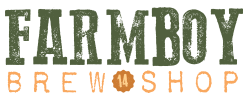Oak Forest resident follows dream with new brew shop
May 16, 2015Brewing beer is not just a commercial enterprise in The Leader area. Increasingly, more people are brewing beer as a hobby, but that doesn’t mean that they aren’t serious about it.
Farmboy Brew Shop, 3814 North Shepherd Drive, just celebrated its year anniversary. The shop offers classes, equipment, hops and other ingredients as well as hands on help and tutorials to those looking to brew beer.
 “It’s a good milestone to have,” said Natalie Weiershausen who works a day job as a civil engineer while helping her husband Landon out with the shop on weekends.
“It’s a good milestone to have,” said Natalie Weiershausen who works a day job as a civil engineer while helping her husband Landon out with the shop on weekends.
Weiershausen said that they started a local group, Brewers of the Hood, a couple of months before the store opened. About six months ago, the group, with about 25 active members, became an official club under seperate leadership although they are still affiliated with Farmboy.
Vice-president Sean McClure said the group holds events each month, such as bottle shares and style meetings where they talk about what goes into making a particular style of beer. They also have three to four beer competitions each year where professional brewers evaluate the entries.
While it might seem daunting to the uniniti ated, Weiershausen says that anyone can brew their own beer.
ated, Weiershausen says that anyone can brew their own beer.
“It’s as easy as you want it to be,” she said. With an extract, the process takes half the time, but for those who really want to get into it – they can go “all grain.” All-grain brewing is the process in which the brewers create the wort, or sweet liquid drained from mash, by extracting the sugars from the malted grain themselves instead of having it done for you as in extract brewing. This allows the brewer much more control over certain characteristics of the finished beer, including color, body, texture and overall malt flavor.
The equipment for brewing costs can be as little as $130 and the ingredients for about five gallons of beer will run you $30 to $50.
Along with the popularity of homebrewing and craft beer, some hops come in and out of fashion, and sometimes Weiershausen says this means farmers cannot produce enough to meet the demand. An example of a ‘hot hops’ is Mosaic, which is rich in fruit and pine notes and can be found in a multitude of different commercial beers as well as homebrew.
Weiershausen also notes that Houston isn’t the best climate for growing hops, but that doesn’t stop intrepid beer brewers from trying.
Kenneth Darmer has been home-growing hops for three years now and although he says his last name is one letter different than farmer, he is still trying to get a good crop.
“I still have a lot of learning to do,” Darmer said.
Darmer says he’s been surprised at how many people he meets who homebrew.
“Houston is a huge city and I think the success of the brick and mortar homebrew supply shops is proof there is a strong homebrew community,” Darmer said. “Growing hops at home is fun and one more way to make your beer personal. It’s good for ‘bonus hops’ to use, but there are lots of variables and uncertainties so it would be somewhat of a risk to rely on them exclusively.”
He notes that breweries typically have contracts with growers to buy a certain amount, and if there are shortages then homebrew supply shops may run out of certain types.
Darmer’s brewing buddy for the past two years, and former college roommate, Tyler Arrington is a geologist who grows his own hops in his backyard.
“I used a variety that should fare well down here in the south, Chinook,” Arrington said. “I’m on my second year, and it provided enough hops to do one 10 gallon batch of beer. So, I suppose in short it is a lot of work, but it is satisfying to know that I was able to hop my beer, with my own.”
He said his plant required a lot of water and that it can grow about two inches a day if it is in the perfect environment.
“I’m fortunate enough to have a friend in Colorado who privately grows upwards of 20 different varieties, and he has coached me quite a bit, although our geography is different here,” Arrington said. “Typically the plant will grow from spring, through fall.”
Homebrewer Paul Phillips says he isn’t into the community facet of brewing as much, but ever since he brewed his first batch in high school, which he and his friend christened Scheißenbock, Phillips had homebrew on the brain. Six years ago, he picked it up again. He says he’s been successful growing hops, specifically the Cascade variety.
“They’re on their second year and produced quite a bit this spring when it was raining consistently,” Phillips said. Although they did not produce a large crop the first year, he now uses them to brew beer.
“I made a batch with hops exclusively from my backyard earlier this year and it was pretty good,” Phillips said.
For some homebrewers, the desire to share their product is the impetus for a commercial endeavor. Darmer and Arrington are exploring the idea of opening their own brew pub.
Of the permitting process, Arrington said it might take a little while but they are excited about the possibility of serving guest beers – as well as their own creations.

